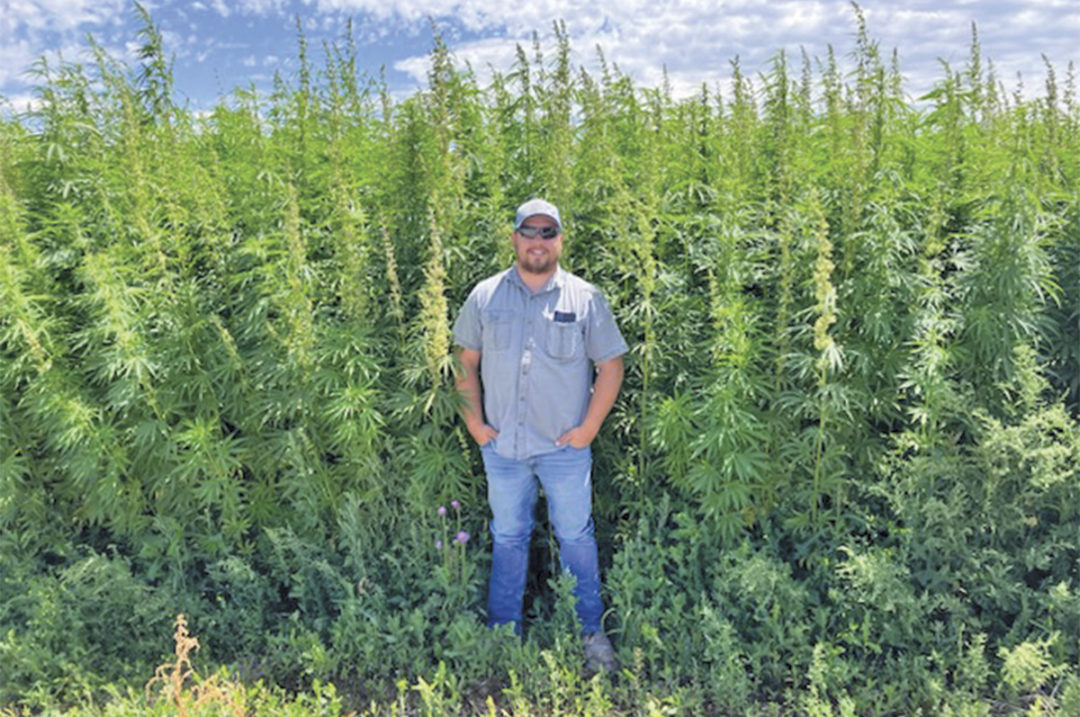Not everything is as it appears. A field of fiber hemp may be deceivingly similar to its cousin marijuana – giving a new meaning to the term “pot-load” when a semitrailer hauls hemp bales down the road. In fact, hemp has been legal to grow in the state of Idaho since 2021, with the caveat that the crop’s THC level be at or below 0.3% for it to be harvested and sold.
While it’s not an experimental drug, it is still considered to be somewhat of an experimental crop within the state. However, a few brave farmers have dug in to try their hand at growing hemp, and so far, they are excited about its future in the field.
Why hemp?
Tim Cornie, owner of 1000 Springs Mill in Buhl, Idaho, was one of the first Idaho farmers to drill hemp seed. Cornie specializes in ready-to-eat products – growing organic beans, popcorn and ancient grains. His interest with the crop sparked when he learned the nutritional benefits of hemp seed.
“It has omega-3s, omega-6s and nine amino acids, and it’s a complete protein. It’s got as much protein as soybeans, but it’s more agreeable to the body,” he notes. Additionally, Cornie likes the idea of a dual-use crop. Hemp fiber is used in building materials and seems to have endless possibilities in that industry going forward.
In eastern Idaho, Triston Sponseller, CEO/founder of Idaho Hemp Processing, operating in partnership with Whitefield Global Holdings, was the first to see the value in operating a processing facility in addition to growing the crop.
He saw hemp as a lucrative alternative crop to wheat, barley and alfalfa – something that could be put into the rotation following potatoes, among many other locally grown crops.

Greg Blahato, hemp inspector for Idaho State Department of Agriculture, surveys Foster’s crop late in the growing season. Photo provided by Josh Foster.
Sponseller acquired a building in Thornton, Idaho, that was formerly the Wilcox potato warehouse and turned it into a hemp processing facility. Working with contracted hemp growers in the area, he receives bales of hemp and processes them into two different products: fiber and hurd.
“Essentially what we’re doing is taking that hemp [stalk] and we’re separating, cleaning and screening it for size. We’re separating the fiber from the hurd and then cleaning the two respective products,” Sponseller explains.
Once the hemp has been processed at Idaho Hemp Processing, it may go several different directions.
“There’s so many different uses for hemp,” he says, “but just to name a few, there’s bedding markets, there’s the automotive industry, there’s the building industry that they’re using it for. They’re even using it as plastic replacement.”
In Ririe, Idaho, Josh Foster of Vista Valley Ag, raises potatoes, barley, white and red wheat, alfalfa and, most recently, fiber hemp.
Foster planted his first hemp crop in 2022. He decided to try hemp because he saw it as an exciting opportunity for his farm.
“I was just really curious as to what else we might be able to work into our standard rotation, the geography and the climate, and the soil types. We found what works on our farms, and we were just excited to see if hemp would work too, and surprise, it works really well!” he says.

Hemp fiber is baled and shipped throughout the country for use in several industries. Photo provided by Triston Sponseller.
Hemp’s potential
All three farmers agree that hemp is a hardy crop and well suited to the Idaho climate, making it a crop with plenty of potential to be incorporated into the standard rotation. Foster says growing industrial hemp is similar to barley. It takes a similar amount of water and fertilizer. According to Sponseller, one of the advantages of hemp is that it removes less organic matter and nutrients out of the soil than barley or wheat.
Cornie farms organically, so he is a little more sensitive to nutrient deficiencies. He says he did notice the hemp crop pulled slightly more nitrogen out of the soil than he was expecting. On the other side, however, during his combining process to harvest the seeds, the fiber is annihilated down to a cottonlike substance, called hurd. Cornie then works that back into the soil.
“Hemp fiber is known to hold three times the water capacity of straw, so they’re using it for bedding for racehorses because it holds so much moisture,” he explains.
Cornie is anxious to see if the hurd will increase the water-holding capacity of his soil during the upcoming growing season.
There are also a few unknowns, like hemp’s tolerance to herbicides and what herbicides will kill volunteer hemp the following year.
Pamela Hutchinson, associate professor and extension specialist in potato cropping systems and weed scientist for the University of Idaho, conducted research during the 2022 and 2023 growing seasons. She studied preemergence and post-emergence herbicide effect on fiber hemp.

Hemp hurd is used as animal bedding material because it can absorb high amounts of moisture. Photo provided by Triston Sponseller.
“There is only one herbicide labeled right now in the United States for fiber hemp, and that is Sonalan. That is sold by a company called Gowen Company.
“We included Sonalan in our trials and compared it with other potential herbicides, many of them labeled for use in potatoes. We did see a few that were safe and also a few that killed the hemp,” notes Hutchinson. “The latter is important to controlling hemp if it volunteers in the next year’s crop.”
She explains that both the University of Idaho and Oregon State University are researching if and how hemp can be incorporated into a potato crop rotation. Progress will be a little slow, however, because of the current lack of approved herbicides.
Hutchinson is working with the USDA, using the IR4 program to solve that problem. IR4 is designed to help specialty crops be added to herbicide labels when they otherwise wouldn’t because of the significant investment required from the chemical company.
There are kinks to work out; 2024 is just year three for the crop, but Sponseller and Foster say the crop still pencils.
“There is a premium for hemp right now because of the restraints that there are to grow it, with the testing and the licensing, but it pays considerably well – about three times more an acre than what our hay crop did,” Foster points out.
The bottom line is: Hemp grows like a weed and is proving to have a bright future in Idaho.
Caution: Not for wheel-line irrigation. This crop can get tall.







